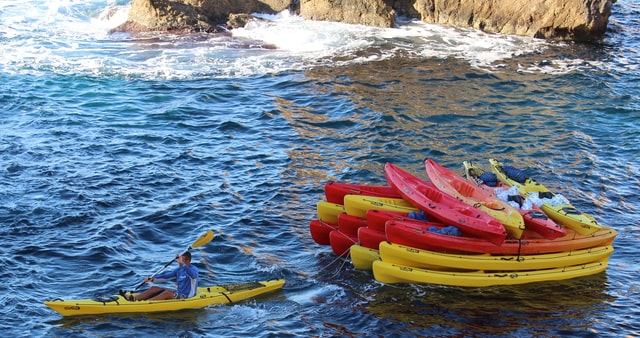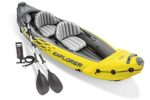How to Transport a Kayak

If you are a newcomer to kayaking, figuring out how to transport a kayak properly can be a challenge. Before you start thinking about stern and bow lines, you should first think about the vehicle you plan on using to ferry your kayak from the home to the water. You will need to consider things like roof types, racking systems and more. Read on for our detailed guide on what steps you need to take when properly securing your vessel and how to transport a kayak correctly.
Determine the Vehicle Roof Type
If you are planning on transporting your kayak on the roof your vehicle, you will need to carry some basic steps beforehand. Roof racks are an essential element for transporting your kayak successfully. A good racking system is not only required to securely cradle your kayak, but will also protect your vehicle and yak from suffering damage when you are on the move. You have a few main options to consider when selecting a roof rack, but you are ultimately limited by the type of vehicle you own. You will also need to assess the roof conditions of your vehicle to decide which racking system you need to invest in.
Some vehicles may include a bare roof without any points for attaching a racking system. Although you may think this means you can not add a racking system for transporting a kayak, you would be wrong. We will discuss how to transport a kayak without a roof rack later on this article.
Other vehicles will include flush or raised side rails. These rails run along the edge of vehicle, parallel to where your vehicle doors are. Raised rails include space between the rail itself and the surface of your vehicle. By contrast, flush rails have no space between the rail and car whatsoever. Vehicle roofs that include side rails provide you with a sturdy point of attachment and are well suited to heavy-duty hard racking systems.
Roof track are somewhat similar to side rails. Just like side rails, these tracks will run parallel to the doors of your vehicles. Many vehicles come with tracks already included, but they can be fairly easy to add to a vehicle with a bare roof. If the top of your car has tracks, it is fairly easy to find a rack system that will it neatly within the track so you can transport your kayak across long distances with ease.
Fixed attachment points are also common with newer vehicles. These concealed fixed points are almost always covered by discreet caps that blend with the bodywork of a vehicle. These caps can be removed to reveal the access points beneath. Once you have removed the caps, you can attach a roof rack and bolt it down firmly in place. If you are looking to transport particularly heavy kayaks, a roof with fixed points on its roof is ideal.
Finally, there are factory crossbars. Crossbars are found on the roof your vehicle between the side rails. If you are lucky enough to have a vehicle that includes pre-installed crossbars, selecting a racking system to transport your kayak is far easier.
Selecting Suitable Roof Rack Systems
After assessing the roof your vehicle and what category it falls into, you can now decide to explore potential roof rack systems for securing your kayak. Soft racks are a good option for kayakers with a vehicle that has a bare roof, tracks or fixed attachment points. Soft racks often include foam blocks or inflatable padding to keep your kayak secure on top of your vehicle and protected from damage while travelling short distances or longer hauls. Soft racks are without doubt one of the simplest options for those with minimal know how. A soft rack is made up of two bars that run horizontally across the roof your car. These bars include heavy-duty straps, with the end of the straps running through the doors of your vehicle so the racking system is kept securely in place. Soft racks also include ratchet straps so you can be confident that any kayak up on the roof of your car is locked firmly in place while you travel. The minimal design and inclusion of tie-down straps make soft racks one of the simplest racking systems to install. They can also be removed from your vehicle with little effort and stored away when you do not need them. They are so small that they can even be stored in the trunk of your car.
Hard racks are a heavy-duty alternative to soft racks. Sometimes referred to as mounted crossbars, these racking systems are a good option if the roof or your vehicle includes racks, fixed attachment points or side rails. They are also compatible with older vehicles with roofs that include gutters. Although hard racks can be a good option for those looking to transport heavier kayaks, they have the downside of being as universal as soft racks. However, more and more kayaking brands and watersport brands are producing a broad range of hard rack systems that means you will have little trouble finding one that meets with your vehicle specifications. If you have decided to use a hard rack system, you should probably think about adding a layer of cushioning to your racking to ensure your kayak is protected from damage. Foam blocks and cushioned padding will prevent your hull from suffering from scratches and dents while you are on the move. Such pads will also include non-slip surfaces that prevent your kayak from moving around in transit. Many leading brands like Yakima and Thule produce a good selection of pads that can be used with hard racks and mounted crossbar systems.
Straps & Stern Lines
Once you have chosen your preferred rack system for the top of your vehicle, you need to start thinking about additional fastenings to ensure your kayak is as secure as possible. Tie-down straps should be the next thing you think about buying. Ratchet straps are a great option for securing kayaks as they are designed to produce high levels of tension when fastened. They will also provide long-lasting hold, making them ideal if you need to drive significant distances with your kayak atop your vehicle. Most of the time, tie-down straps are sold in pairs. This means you can secure each end of the kayak, distributing weight evenly across the roof of your vehicle. To prevent unnecessary damage to the roof your vehicle and the hull of your kayak, make sure any straps you buy feature padded covers that encase the buckle elements.
If you are looking to transport a longer kayak, you need to be thinking about stern and bow lines. IN most cases, all you need for this are two lengths of rope. Bow and stern lines are not really intended to secure your yak to your vehicle, but instead serve as stabilisers to prevent it from moving back and forth as your vehicle chances speeds.
Additional Accessories
If you need to travel many hundreds of miles with your kayak on the top of your vehicle, you should think about purchasing some additional items to make transporting your yak as effortless as possible. You will find many specialist kayak mounts and holders on the market, providing your kayak with a stable base and plenty of support for those longer journeys. These types of mount are intended to keep your yak from moving around when your vehicle is accelerating. If you plan on spending a considerable amount of time on the road, you will be changing speed many times, which is when your kayak is most likely to shift around. Kayak holders and mounts are designed to be used with roofs with tracks, but they can also be mounted on crossbars with ease.
Other worthwhile investments to consider are J-Cradles. If you need to secure a yak or watercraft on its side, J-Cradles are ideal. This holders mean you can stack boats on their side, without worrying about the hull becoming warped when tied down for long periods of time. Although J-Cradles require some installation, they are very user-friendly and, when they are no longer needed, can be folded down discreetly. Another great thing about J-Cradles is that they can be used with a wide range of kayaks and other boats, making them a must for any watersport enthusiast.
How to Load a Kayak Correctly
Once you have selected a suitable rack system and additional fasteners and have installed them correctly, you can start putting them to good use. The easiest way to load a kayak is for two people to lift the yak directly from the ground and place it atop the roof of your vehicle. A kayak should be placed on top of the roof of your car with the bow side at the front and the stern at the rear. If you are loading your yak onto a rack system, you should ensure that your vessel is placed upside down, with the underside of the hull facing upwards. If instead you are using a cradle or yak holder, you will need to load it with the right side facing upwards. This is because the hull will need to be slotted into the cradle itself.
If you are travelling solo, loading your kayak can be a little more demanding. Therefore, it makes sense to consider purchasing a loading accessory o two. One option to consider is a kayak loader system. These are made up of moulded frames that are attached to the body of your car via suction cups. With these added to your vehicle, you do not have to lift the kayak from the ground to the roof in one movement. Instead, you can gently guide the kayak through the recesses, sliding it up along the rear of your car and onto the roof. When the loading is done, you can remove this loader guides and store them away in the trunk of your vehicle until you need them again.
Securing Kayaks
Once your kayak has been successfully loaded onto the roof of your vehicle or racking system, you will need to secure it in place with tie-down straps. For the best results, you should space out the straps you are using to distribute the kayak weight evenly across the top of your vehicle. If you are using a hard rack system, you will need to secure the straps within the rack housing itself so they do not fall free in transit. Soft racks come with attachment points that make it easier to fasten straps. In the case of inflatable roof racks, you will need to feet tie-down straps through the doors of your vehicle in order to keep them firmly attached.
After straps have been fastened in place, they also need to be tensioned. You do not want to tension them too tightly however, as this can damage your kayak and warp the shape of a hardshell hull. To determine whether you have applied the correct amount of tension, all you need to do is try to lift the bow of your vessel. If straps have been properly tensioned, the kayak will remain still and not move. If you do detect some movement, place the kayak flat again and adjust your tie-down straps to apply more tension. Finally, you will need to add bow and stern lines. You need to use a rope of length for either end of the kayak, so make sure you have sufficient material to hand. To begin, attach a length of rope to the front bumper of your vehicle. Do the same at the rear bumper. Each length of rope should be attached to the handles found at either end of your kayak. You do not need to apply as much tension when securing bow and stern lines. They should only be secure enough that they prevent your kayak from sliding forwards and backwards when your car is moving.
Hit the Road
Once all the above steps have been taken care of, you are ready to hit the road. If you are going to be embarking on a particularly long journey, you should certainly check the tensioning of tie-down straps when you come to a stop for rest breaks. You may also want to consider the tyre pressure of your vehicle, as it may need to be increased to compensate for the additional load of your kayak.





